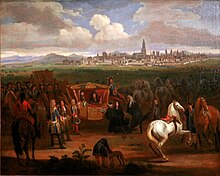Province of Alsace
This article needs additional citations for verification. (November 2021) |
| Province of Alsace Province d'Alsace | |||||||||||||
|---|---|---|---|---|---|---|---|---|---|---|---|---|---|
| 1648–1790 | |||||||||||||
King of France | | ||||||||||||
• 1648–1715 | Louis XIV | ||||||||||||
• 1774–1790 | Louis XVI | ||||||||||||
| Governor General of Alsace | |||||||||||||
• 1788–1789 | Jacques Philippe, Marquis de Choiseul-Stainville | ||||||||||||
| Historical era | Early Modern | ||||||||||||
| 1648 | |||||||||||||
• Decree dividing France into departments | 1790 | ||||||||||||
| |||||||||||||
The Province of Alsace (Province d'Alsace) was an administrative region of the
History
In 1469, following the
By the time of the

This situation prevailed until 1639, when most of Alsace was conquered by France to keep it out of the hands of the
France consolidated its hold with the 1679
Government

Following the governmental reforms of 1773, the Province of Alsace formed part of the Government of Alsace (Gouvernement d'Alsace). The province itself was further divided into two 'regions': Lower Alsace (North) and Upper Alsace (South).[2]
Following the Decree dividing France into departments announced on 22 December 1789, the Province of Alsace was disestablished and formed the departments of Bas-Rhin (Lower Rhine), Haut-Rhin (Upper Rhine), and part of Moselle.
Culture
Alsace historically was part of the Holy Roman Empire and the German realm of culture. Since the 17th century, the region has passed between German and French control numerous times, resulting in a cultural blend. German traits remain in the more traditional, rural parts of the culture, such as the cuisine and architecture, whereas modern institutions are totally dominated by French culture.
Symbolism
Strasbourg
Flags
There is controversy around the recognition of the Alsatian flag. The authentic historical flag is the Rot-un-Wiss; Red and White are commonly found on the coat of arms of Alsatian cities (Strasbourg, Mulhouse, Sélestat...)
Language
Although German dialects were spoken in Alsace for most of its history, the dominant language in Alsace today is French.
The traditional language of the région is
Although Alsace has been part of France multiple times in the past, the region had no direct connection with the French state for several centuries. From the end of the Roman Empire (5th century) to the French annexation (17th century), Alsace was politically part of the German world.
The towns of Alsace were the first to adopt the German language as their official language, instead of
Footnotes
- ISBN 978-0-19-880493-2.
- ^ "Alsace | History, Culture, Geography, & Map | Britannica". www.britannica.com. Retrieved 2021-11-30.
- ^ "Unser LandBrève histoire d'un drapeau alsacien". Unser Land.
- ^ Genealogie-bisval.net
- ^ "Colmar : une statue de la Liberté en "Rot und Wiss"". France 3 Alsace. 16 November 2014.
Further reading
- Gerson, Daniel. Die Kehrseite der Emanzipation in Frankreich: Judenfeindschaft im Elsass 1778 bis 1848. Essen: Klartext, 2006. ISBN 3-89861-408-5.
- Kaeppelin, Charles E. R, and Mary L. Hendee. Alsace Throughout the Ages. Franklin, Pa: C. Miller, 1908.
- Lazer, Stephen A. State Formation in Early Modern Alsace, 1648–1789. Rochester: University of Rochester Press, 2019. Archived 2019-06-12 at the Wayback Machine
- Putnam, Ruth. Alsace and Lorraine: From Cæsar to Kaiser, 58 B.C.–1871 A.D. New York: 1915.



